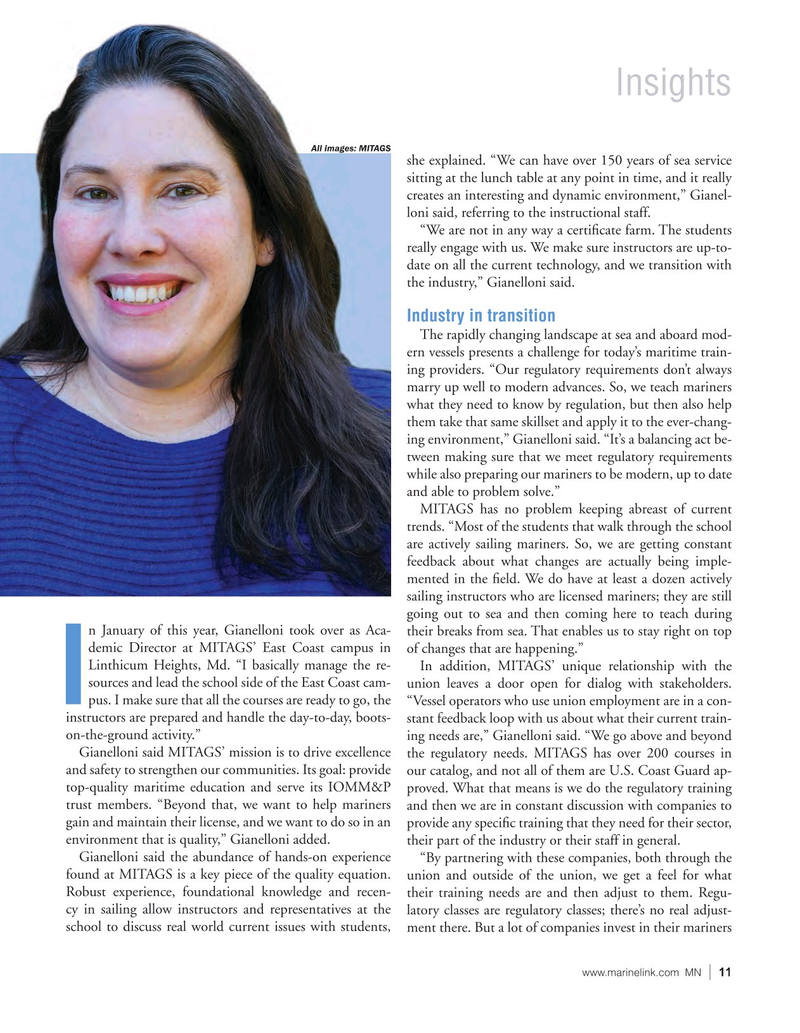
Page 11: of Marine News Magazine (February 2024)
Read this page in Pdf, Flash or Html5 edition of February 2024 Marine News Magazine
Insights
All images: MITAGS she explained. “We can have over 150 years of sea service sitting at the lunch table at any point in time, and it really creates an interesting and dynamic environment,” Gianel- loni said, referring to the instructional staff.
“We are not in any way a certi? cate farm. The students really engage with us. We make sure instructors are up-to- date on all the current technology, and we transition with the industry,” Gianelloni said.
Industry in transition
The rapidly changing landscape at sea and aboard mod- ern vessels presents a challenge for today’s maritime train- ing providers. “Our regulatory requirements don’t always marry up well to modern advances. So, we teach mariners what they need to know by regulation, but then also help them take that same skillset and apply it to the ever-chang- ing environment,” Gianelloni said. “It’s a balancing act be- tween making sure that we meet regulatory requirements while also preparing our mariners to be modern, up to date and able to problem solve.”
MITAGS has no problem keeping abreast of current trends. “Most of the students that walk through the school are actively sailing mariners. So, we are getting constant feedback about what changes are actually being imple- mented in the ? eld. We do have at least a dozen actively sailing instructors who are licensed mariners; they are still going out to sea and then coming here to teach during n January of this year, Gianelloni took over as Aca- their breaks from sea. That enables us to stay right on top demic Director at MITAGS’ East Coast campus in of changes that are happening.”
Linthicum Heights, Md. “I basically manage the re- In addition, MITAGS’ unique relationship with the sources and lead the school side of the East Coast cam- union leaves a door open for dialog with stakeholders. pus. I make sure that all the courses are ready to go, the “Vessel operators who use union employment are in a con-
I instructors are prepared and handle the day-to-day, boots- stant feedback loop with us about what their current train- on-the-ground activity.” ing needs are,” Gianelloni said. “We go above and beyond
Gianelloni said MITAGS’ mission is to drive excellence the regulatory needs. MITAGS has over 200 courses in and safety to strengthen our communities. Its goal: provide our catalog, and not all of them are U.S. Coast Guard ap- top-quality maritime education and serve its IOMM&P proved. What that means is we do the regulatory training trust members. “Beyond that, we want to help mariners and then we are in constant discussion with companies to gain and maintain their license, and we want to do so in an provide any speci? c training that they need for their sector, environment that is quality,” Gianelloni added. their part of the industry or their staff in general.
Gianelloni said the abundance of hands-on experience “By partnering with these companies, both through the found at MITAGS is a key piece of the quality equation. union and outside of the union, we get a feel for what
Robust experience, foundational knowledge and recen- their training needs are and then adjust to them. Regu- cy in sailing allow instructors and representatives at the latory classes are regulatory classes; there’s no real adjust- school to discuss real world current issues with students, ment there. But a lot of companies invest in their mariners www.marinelink.com MN 11|

 10
10

 12
12
